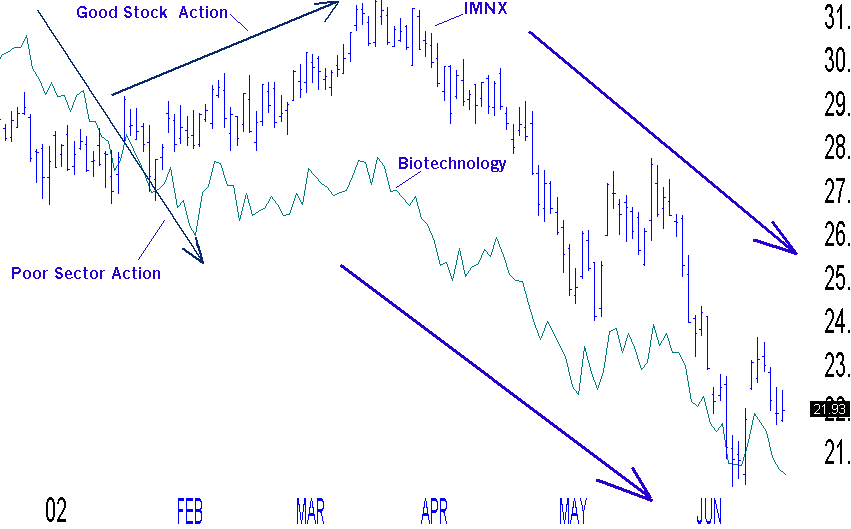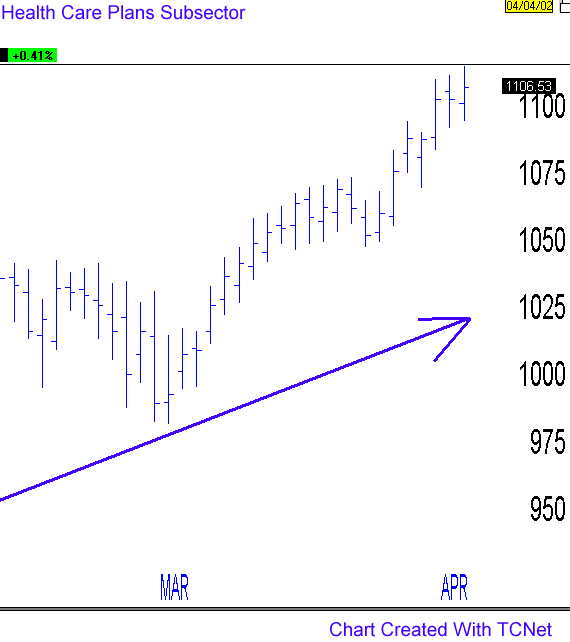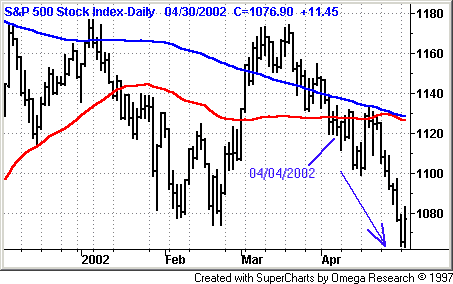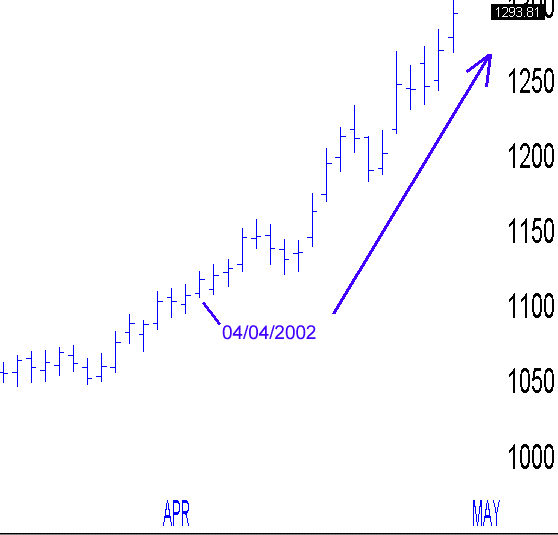How To Find Strong Stocks In Both Up And Down Markets
This is a
transcript of a live TraderTalk workshop conducted by TradingMarkets Director of
Research, Dave Landry, on Thursday, July
11, 2002.
Eddie Kwong:
Dave how are you doing?
Dave Landry:
Great!
Kwong: Dave,
I heard that you recently finished taping your video course, “Swing
Trading for a Living,” Can you give us a taste of what you teach in the
video? What
are the key elements of successful swing trading?
Landry:
For me,
successful momentum-based swing trading involves the following elements which include: basic money management; identifying trend pullbacks; and stock
selection. Then it’s a top-down approach starting with the market. This includes
discretionary analysis (where
is the big blue arrow?); OB/OS analysis (where has price gone lately?). Systems:
Close count, TRIN Reversals, VIX
H/L, CVR III/CVR III-Modified and Oscillator Swing System (all test out between
60 to 90% accurate over three to seven days). Then I go to
sectors. I use discretionary analysis (i.e., blue arrow stuff) and sector sorts
(which I will cover in a minute). I then look to the setups. These are trend
resumption setups, trend acceleration setups and trend transition resumption
involves patterns such as pullbacks, TKOs, DT-TKOs, Witch Hats, acceleration:
explosion gap pivots and accelerating momentum strategy (AMS) transition: first
thrusts and bow ties. It also involves other stuff like being prepared (the
night before) and understanding the psychology of yourself and the market.
Kwong: I have no doubt that you need all of these components working together in order to attain
consistent enough results to swing trade for a living. But I know you
would like to cover one area in depth today…correct?
Landry: Right. Eddie, one
of my favorite areas of
research is sectors. I would like to cover that in detail today, I’ll then open
it up for questions, on anything listed above.
Kwong: Sounds
good.
Landry:
Refer to the charts. Notice Chart
1 has biotech
plotted as the green line; Immunex
(IMNX)
is shown in the blue bars. Notice the divergent behavior. In and of itself, IMNX
might look like a potential momentum stock. However, biotech, the line below the
chart, is headed south.

![]()
Chart
1.
NOTICE THAT THE STOCK CATCHES UP
TO THE SECTOR. In about 90% of the cases, this happens. SO
YOU WANT TO BE IN THE BEST SECTORS! As I mentioned above, a top down
approach MARKET-SECTOR-STOCKS
(SETUPS) is the best approach.
Referring to Chart #2,
notice that the stock market is somewhat “iffy.”

Chart
2.
Now look at the way I’ve sorted sectors in the following table. This was done
by sorting based on the time period illustrated in the chart below the sector
sort. Even though the market has headed lower, there was some positive sectors NOTABLY,
the health care related issues.


Chart
3.
Now, look at Chart 4.
Notice the how the Subsector is set up as a cup and handle (a running cup and
handle) or, if you prefer, a pullback. Notice the sector line, (Health care
plans) making new highs and in a strong trend.

![]()
Chart
4.
On the next chart I have the Health care plans plotted by
themselves.

![]()
Chart
5.
NOTICE The big
blue arrows?
Now, let’s walk forward. The stock market falls out of bed (Chart
6) BUT HMOs
(health care plans) go straight up (Chart
7) as does the
stock.

Chart
6.

![]()
Chart
7.

![]()
Now, go to the next table… Notice how HMOs have risen to #1.
This is known as “delta” relative strength As you can see, it pays to
put the sectors behind you.
Chart
8.

…and all the while the overall stock market is headed lower.

Chart
9.
Kwong: Dave will now answer questions that he has received
via email.
Question: Dave,
a few words about this new indicator “First Thrust.” Also if we get a
bull market, can we use it in reverse direction?
Landry:
First thrust
is a setup where you have STRONG thrust from a major low/high. You then enter on
the FIRST signs of pulling back. YES, they work best in TRANSITION markets.
After Sept. 11, a plethora of stocks set up like this……
Kwong: Can you cite
a recent example of that, Dave?
Landry: YES,
the aforementioned HMOs topped out and formed first thrusts. Anthem
(
ATH |
Quote |
Chart |
News |
PowerRating) is the
most recent example here…(checking charts). It set up on 06/27 and triggered
on 07/01. It then formed a Witch Hat, which it broke down out of on 07/08.
Kwong: Looking at the
chart of ATH, it appears that it pulled up a bit before resuming a downtrend.
Where you were able to capture the second leg?
Landry:
Yes, sometimes you get a big leg and sometimes it retraces and sets up again. I
LOVE these transition patterns, especially when the sector itself is breaking
down.
Question: How do you know around 6/26 that [ATH|ATH]
isn’t just a pullback off a high that should be bought? Isn’t the momentum still
decent then?
Landry:
Great question! FIRST, the whole HMO sector was breaking down. Second, look at
the velocity in which the stock broke down. OK, the stock is in pretty much a
free fall. The sector is in a free fall. SO, you have to be on your toes….this
is how you catch a market transition. Look for bowties, first thrusts or first
pullbacks
Question: With ATH, isn’t
it easier to say that on the sharp pullback, it penetrated the 50-MA for the
first time this year and then pulled back to it, making it a good short? Also it
had strong volume on this pullback to the 50-MA but couldn’t break it.
Landry: I
recognized it as a pattern I trade (First Thrust), but I can’t argue with that
analysis. NICE JOB!
Question: In
your table below Chart 2, what are you actually measuring to compare the
sectors? Is it price action or some other indicator?
Landry:
OK, I am picking a time period in the S&P and then sorting on sector. SO, it
shows me the hottest (or weakest, by reversing the sort order) sectors.
Question:
Over what time period are
you measuring relative strength to sort your sectors? One month? (Dave,
your work has been quite helpful to my trading.)
Landry: OK,
look at a LOT of periods, 1 day, 1-week, 1 month. PICK swing highs and lows.
This is how you get a “Feel” for what’s going on. I’ll tell you a
secret too. If you work hard, you will be trading stocks for 3-months…then on
CNBC, you’ll here “The XXX sector is up 300% this year, it’s the hottest
sector.” THAT’S A GREAT
TIME TO GET OUT.
Time and again, I laugh my a** off when I’ve been trading a sector for months
and then here it announced on CNBC. For example, the HMO’s were announced as
HOT, right as they topped.
One thing I forgot to mention is that I study the sectors every night as I flip
through hundreds of charts…So, if I see 10 semis set up as pullbacks from
lows, I then check out the SMH and SOX and if they too are setup, I know it’s
going to be a good day.
Kwong: Everybody’s
talking about gold…is it a good time to take profits based on what you just
said?
Landry: Exactly.
Gold broke down out of an inverted cup and handle a few weeks ago. Now it’s
retraced.
Question: Go back and talk more about your DELTA.
Landry: OK,
let’s say we are measuring temperature. If I tell you the temp is 95, then
you’ll know it’s HOT but, what if I told you it was 100 just 10 minutes ago? The
“delta” (difference) is very meaningful. You find the delta by looking
at a lot of periods
td606: A perfect
example regarding CNBC is that after the Russell 2000 moved up the first five
months they finally put the R2K bug along with the other indexes.. That was the
very top.
Landry: GREAT
ANALYSIS!
td606: You’re
welcome.
Kwong: Dave, any sectors you see that have yet to break
down…which would be a potential opportunity for shorts today?
Landry: HMOs
were the last area of strength and now it looks like insurance has caught up.
Most sectors have already broken down…so it’s a little late in the cycle for
transition patterns…. but guess what, these patterns will play themselves out
over and over again.
Question: Is
TradingMarkets.com a good place to find the top sectors in the market indicators
sections or do you need to set up your own sector analysis?
Landry: I
think trading takes a lot of hard work. Definitely look at the TM lists, but do
your on homework too… Don’t wait for someone to TELL you what’s hot/cool, find
it yourself!
Question: Without
giving away specifics you don’t want to reveal, could you elaborate on the
concept behind your closing count system? Is it the same concept as some of Tom
DeMark’s work?
Landry: I don’t
understand DeMark. Remember, I’m a trend-following moron. The close count looks
for an ob/os condition based on consecutive closes…it’s really simple.
Question: What role does volume play? By strong thrust you mean
engulfing bar off of major resistance line or…?
Landry: You know,
I’m a real purist. I mainly look at price but yeah, I bet all those HMO’s broke
down on heavy volume.
Question: When do you lock in profits?
Landry: OK,
first, when I lock in half when my profit = my initial risk. This gives me some
income and a “free ride” on the second half… Some may think this has
a negative expectancy, but this isn’t true, the idea is to hit the occasional
home run on the second loaf….look at AOC an insurance company mentioned
recently as a short in my service. NOW, there’s a lot more to it than that, You
might look to lock in profits AS a profit target is approached and the market
/sector is turning OR you might let it ride if the market/sector is in gear. You
have to come to work and pay attention to conditions.
Question: Might
the homebuilders be an example of a potential transition right now?
Landry: Possibly.
The problem is that they have been really choppy lately……and only a few
stocks were leading the index…but you got the idea.
Question:
Do you think the general
market is at a bottom? What are the most important things you are looking for to
judge that the general market is in a trend change from the current down trend
to a new up trend? Or do you think we are just in a pullback off of the down
trend?
Landry: OK,
FIRST, I follow the big blue arrows…I think we are in BOUNCE mode here and I
will look to short the next bounce…….. with that said, many stocks look
really sold out………so, I’d prefer if we had a decent bounce before shorting
again. One last point, I am not the king of all bears, I just look at charts as
a six-year old would……and, off of the September lows, there were some great
transitional longs! So there is opportunity in a bear market (e.g., the HMOs
mentioned in the sector talk earlier)….
Question: The moral of your story is to trend trade by sector when you
see a reversal trend in a sector or a strong sector. You then trade the stocks
strength within this sector ? Or the entire sector?
Landry: Great
question. YES follow the trend, notice the aforementioned HMO’s had
thrusts/pullbacks and thrusts. THEN Notice they broke down…..DO NOT PICK
TOPS…but when you see a meltdown….look to enter on the first pullback. One
last point, yes, when I see 10 semis set up, I might pick one or two and also
trade the SMH to make sure I get a piece of the move…. BTW, you want the holy
grail? Only trade when the sectors are setup…….you will thank me for that
one.
Question: When you are looking to re-enter short positions after the
bounce, do you look at the immediate short term trend line, Fib retracements,
moving averages, oscillators or a combination of the above when they all agree
to decide to re-enter? Or do you just use your setups you described earlier:
pullbacks, TKO’s, etc.?
Landry:
OK, if I get scared out of the position, then I might re-enter on an intraday
basis. However, most of the time I try not to micromanage the positions. My
re-entries become another setup. For instance, notice that ATH broke down then
retraced/set up again and then broke down again. When I see something juicy like
that, I stalk it and wait for the next setup (TKO, PB, etc.).
Kwong: Dave…we’re
about out of time. Thanks for joining us. For more information about Dave’s new
strategies, click
here.
Landry:
Thanks for listening to me!
Kwong: You
will get complete details about his new video course.
Landry: If
any of your questions went unanswered, email
me! I promise to reply to all!
Kwong: Great…thanks
Dave, enjoy your gumbo tonight. Let everybody now in your column
what animal you used.
Landry:
Will do!
Kwong: Later.
Landry:
Good night.
Eastshore: For a Cajun, he makes good sense!
